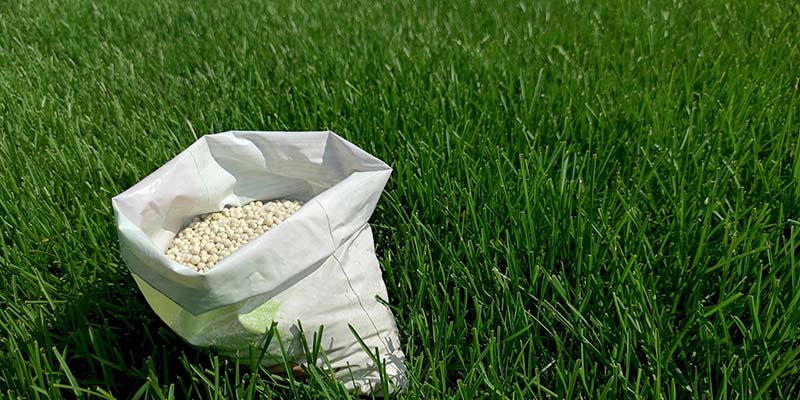Let’s talk fertilization! One key to maintaining a healthy and beautiful lawn is consistency in fertilization. But not all grasses are created equal, so it’s important to know proper fertilization techniques and fertilizer products on the market for your grass type.
FERTILIZER BASICS
Benefits
Over time, through watering and mowing, lawns will become depleted of the vital nutrients needed to keep roots strong and dense, and blades robust and vibrant green. Fertilizing on a regularly scheduled basis will keep your lawn lush, and will help it more effectively fight off pests, weeds, and/or disease that may try to take over.
Fertilizer Components – (N-P-K)
Typically, fertilizers contain a combination of Nitrogen, Phosphorous, and Potassium (N-P-K). The combinations of these three elements will be displayed on the product itself, for example in combinations like 16-4-8, 10-10-10, etc., depending on the percentage of each ingredient. They can often include other ingredients like: Ammonia, Zinc, Magnesium, and more. Your local garden center representative can help to guide you in the right direction based on your needs, but here’s an intro into the types.
TYPES
The difference between products comes in how those ingredients are derived—from chemicals or natural elements.
Synthetic
Synthetic, or Inorganic, lawn fertilizers contain a mixture of chemically derived ingredients that help to treat lawns more quickly because they can be absorbed by the plant in a shorter period. They offer a precise and consistent amount of nutrients, which make maintaining a healthy lawn easier.
Synthetic fertilizers are popular because of their fast-acting properties, ease of use, they’re readily available at lawn and garden stores, and they are generally more cost-effective than organic options. They can come in granular or liquid forms. The options are abundant, with many brands carrying “all purpose” fertilizer choices. These products are known to be pet friendly.
Organic
Organic fertilizers have been shown to enhance soil health first, and therefore can take a little longer to take effect, but once they do, you can rest assured that both soil and plant are getting the nutrients they need. Again, also containing Nitrogen, Phosphorous, and Potassium, these ingredients are naturally derived from seaweed, bone meal, manure, blood meal, fish emulsion, and many other organic substances. Organic fertilizers tend to be bulkier and tend to have a higher price point than their synthetic counterparts. They are also beneficial in protecting lawns by encouraging good pests like ladybugs and bees that help to keep unwanted pests at bay. These fertilizers are known to be pet and environmentally friendly.
FREQUENCY
Generally, it’s good practice to fertilize in eight-to-ten-week intervals, depending on your lawn’s color. It’s always important, however, to follow the label’s directions based on the product you’re using. Fertilizer needs vary by grass type and season.
Elite Plus (Fescue)
Fertilize fescue 7 days after installation and in eight-to-ten-week intervals, depending on your lawn’s color. Avoid applying a fertilizer with high Nitrogen content in the summer and instead use Iron to maintain color.
Hybrid Bermuda and St. Augustine
Fertilize these sod varieties in eight-to-ten-week intervals during warm weather, depending on your lawn’s color. The optimum times for fertilization are spring and summer, with no fertilization required during winter dormancy.
It’s important to note, that over time, the soil-beds can become compacted and hard, limiting its ability to properly absorb water and nutrients. Therefore, it is important to aerate areas of low traffic every two-to-three years, and one-to-two years for high traffic areas.
MISTAKES TO AVOID
Fertilizer Burn
When improperly applied, fertilizer burn can occur. This happens with over-fertilization and when the nitrogen salts in the fertilizer cause dehydration in the plant tissues, causing it stress resulting in burn-like patches. While lawns can recover from fertilizer burn, it’s better to avoid this problem altogether by properly following label directions, using a slower-release product, and watering thoroughly after applying granular products. Using high-Nitrogen fertilizers on Fescue in summer heat can easily burn the plant and hurt plant health.
Fertilizer Stripes
Fertilizer stripes are the appearance of discolored stripes on the lawn caused by not consistently aligning the spreader across each pass that is made, resulting in gaps that are left. Some stripes will be darker green, while alternating stripes will be lighter. To avoid, use a drop or broadcast spreader, pay attention to the edge of where the fertilizer hits the lawn, and ensure there is little overlap or gaps between passes. Another option is to fertilize in two directions at half the application rate.
Applying Too Much
Applying too much fertilizer can dry out the soil and cause damage or even kill your lawn. And much like the burn discussed above, the nitrogen and salt levels become too high and burn the lawn. This is counterintuitive to what fertilizers are designed for, again, your best friend is going to be following label instructions and monitoring your lawn for signs of distress.
If your lawn has not been properly and consistently maintained leading up to the application of fertilizer, it’s recommended to err on the side of ‘less is more’ to start. These lawns may have a harder time properly absorbing nutrients that first time around. Once a healthy routine is established, more fertilizer can be applied at the next application, if needed.
Fertilization is a vital step in lawn maintenance that should not be neglected. Soil can only provide a limited amount of nutrients needed by your lawn to stay healthy and strong. With constant watering and mowing, lawns require a regular application of fertilizer to replenish vital nutrients. With proper fertilization and maintenance, your lawn will remain healthy for years to come.
For more information on caring for your lawn, check out our seasonal lawn care guides.



